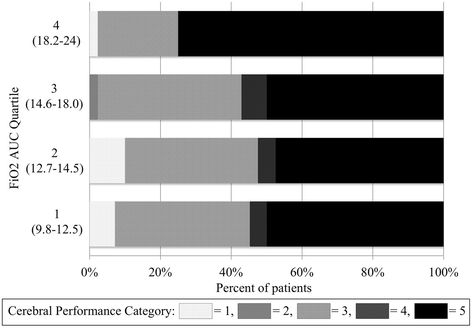Exposure to high concentrations of inspired oxygen does not worsen lung injury after cardiac arrest
- PMID: 25888131
- PMCID: PMC4371614
- DOI: 10.1186/s13054-015-0824-x
Exposure to high concentrations of inspired oxygen does not worsen lung injury after cardiac arrest
Erratum in
-
Erratum to: Exposure to high concentrations of inspired oxygen does not worsen lung injury after cardiac arrest.Crit Care. 2015 Sep 15;19(1):341. doi: 10.1186/s13054-015-1053-z. Crit Care. 2015. PMID: 26373827 Free PMC article. No abstract available.
Abstract
Introduction: Post-cardiac arrest patients are often exposed to 100% oxygen during cardiopulmonary resuscitation and the early post-arrest period. It is unclear whether this contributes to development of pulmonary dysfunction or other patient outcomes.
Methods: We performed a retrospective cohort study including post-arrest patients who survived and were mechanically ventilated at least 24 hours after return of spontaneous circulation. Our primary exposure of interest was inspired oxygen, which we operationalized by calculating the area under the curve of the fraction of inspired oxygen (FiO₂AUC) for each patient over 24 hours. We collected baseline demographic, cardiovascular, pulmonary and cardiac arrest-specific covariates. Our main outcomes were change in the respiratory subscale of the Sequential Organ Failure Assessment score (SOFA-R) and change in dynamic pulmonary compliance from baseline to 48 hours. Secondary outcomes were survival to hospital discharge and Cerebral Performance Category at discharge.
Results: We included 170 patients. The first partial pressure of arterial oxygen (PaO₂):FiO₂ ratio was 241 ± 137, and 85% of patients had pulmonary failure and 55% had cardiovascular failure at presentation. Higher FiO₂AUC was not associated with change in SOFA-R score or dynamic pulmonary compliance from baseline to 48 hours. However, higher FiO₂AUC was associated with decreased survival to hospital discharge and worse neurological outcomes. This was driven by a 50% decrease in survival in the highest quartile of FiO₂AUC compared to other quartiles (odds ratio for survival in the highest quartile compared to the lowest three quartiles 0.32 (95% confidence interval 0.13 to 0.79), P = 0.003).
Conclusions: Higher exposure to inhaled oxygen in the first 24 hours after cardiac arrest was not associated with deterioration in gas exchange or pulmonary compliance after cardiac arrest, but was associated with decreased survival and worse neurological outcomes.
Figures
References
-
- Peberdy MA, Kaye W, Ornato JP, Larkin GL, Nadkarni V, Mancini ME, et al. Cardiopulmonary resuscitation of adults in the hospital: a report of 14720 cardiac arrests from the National Registry of Cardiopulmonary Resuscitation. Resuscitation. 2003;58(3):297–308. doi: 10.1016/S0300-9572(03)00215-6. - DOI - PubMed
-
- Neumar RW, Nolan JP, Adrie C, Aibiki M, Berg RA, Bottiger BW, et al. Post-cardiac arrest syndrome: epidemiology, pathophysiology, treatment, and prognostication. A consensus statement from the International Liaison Committee on Resuscitation (American Heart Association, Australian and New Zealand Council on Resuscitation, European Resuscitation Council, Heart and Stroke Foundation of Canada, InterAmerican Heart Foundation, Resuscitation Council of Asia, and the Resuscitation Council of Southern Africa); the American Heart Association Emergency Cardiovascular Care Committee; the Council on Cardiovascular Surgery and Anesthesia; the Council on Cardiopulmonary, Perioperative, and Critical Care; the Council on Clinical Cardiology; and the Stroke Council. Circulation. 2008;118(23):2452–83. doi: 10.1161/CIRCULATIONAHA.108.190652. - DOI - PubMed
Publication types
MeSH terms
Substances
Grants and funding
LinkOut - more resources
Full Text Sources
Other Literature Sources
Medical


